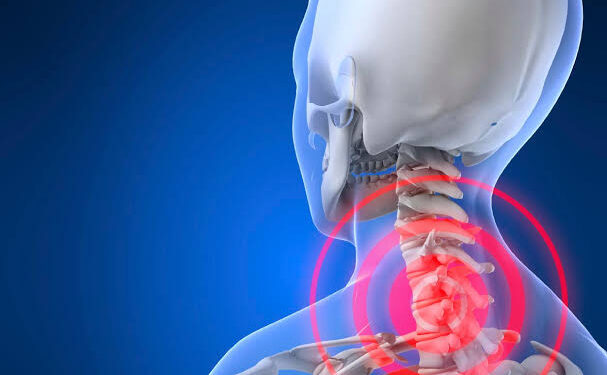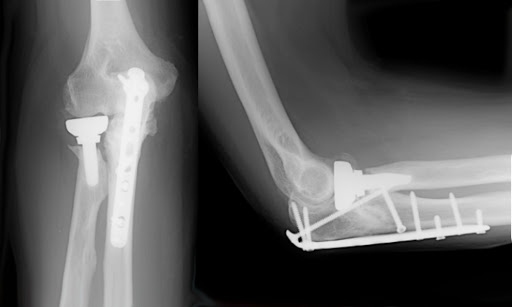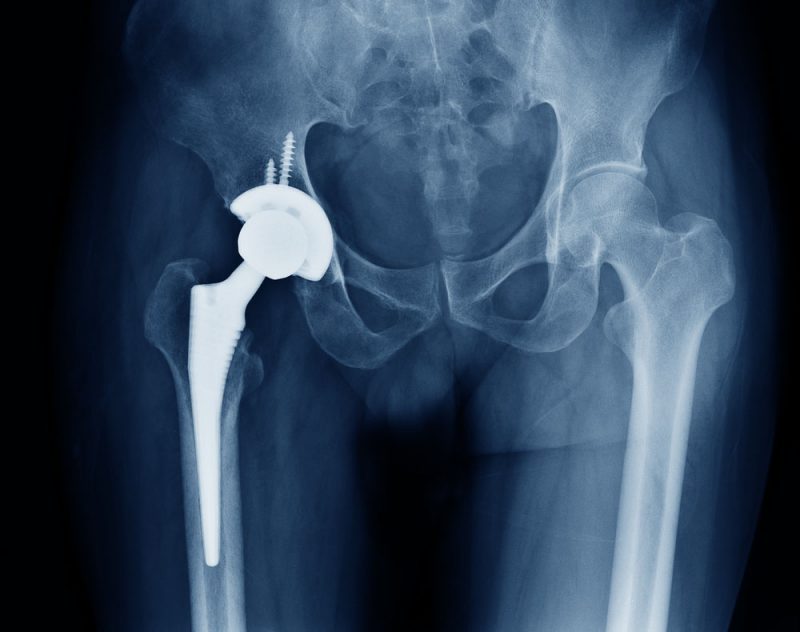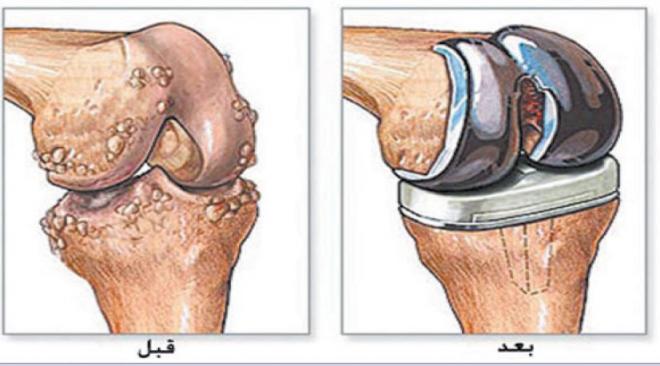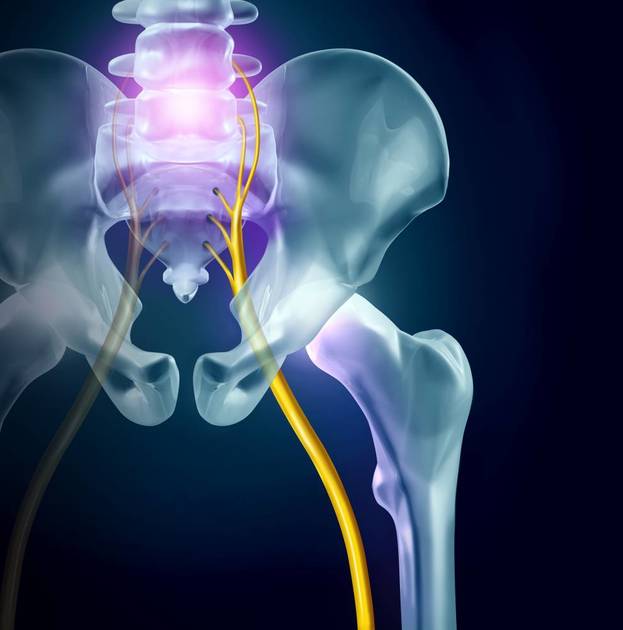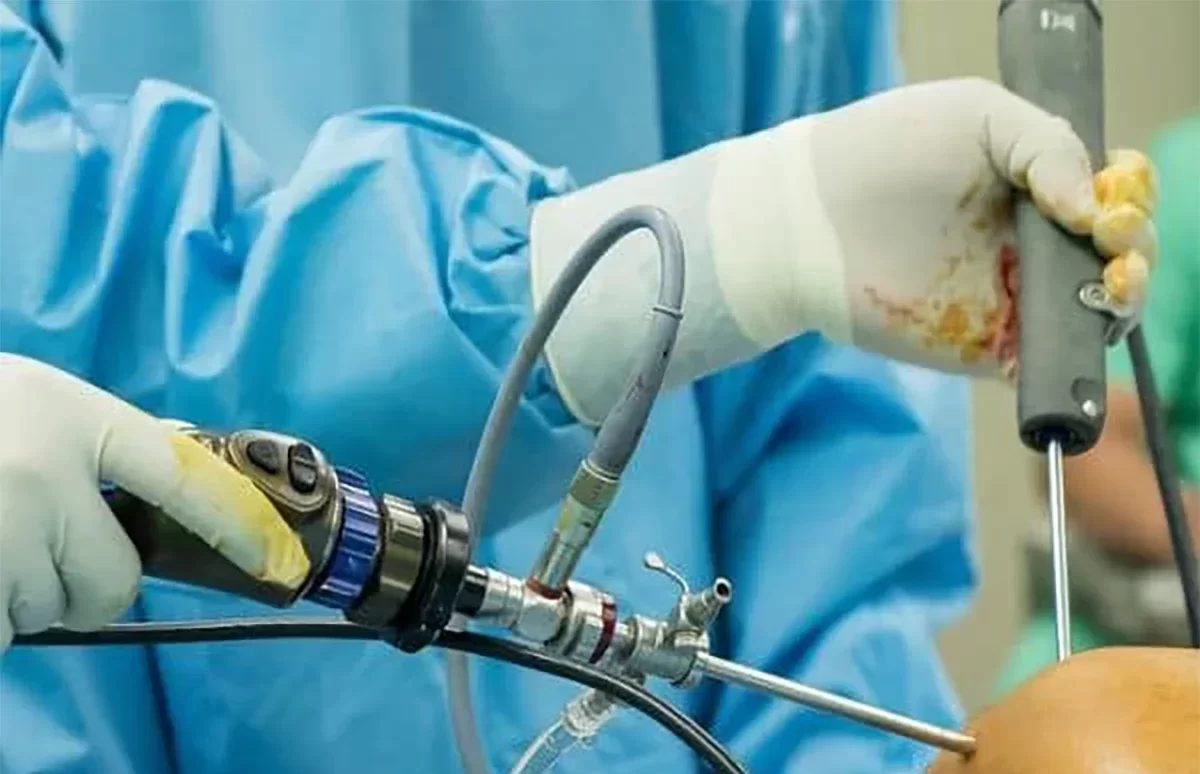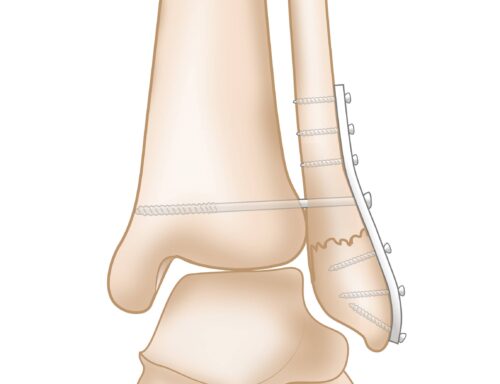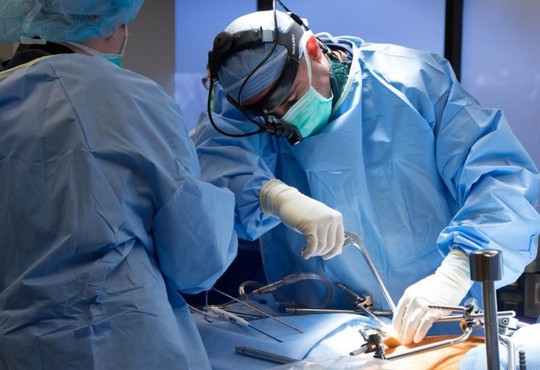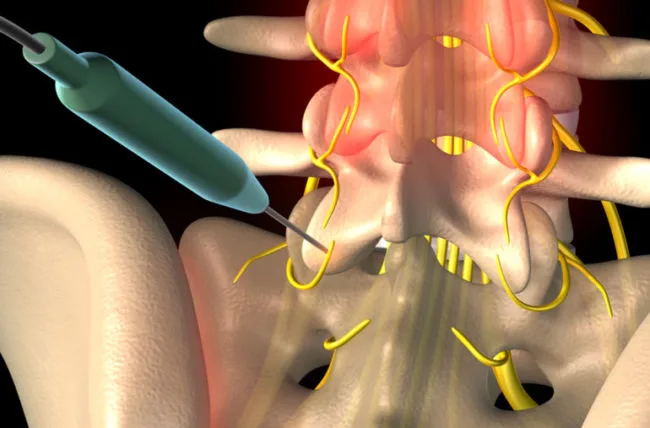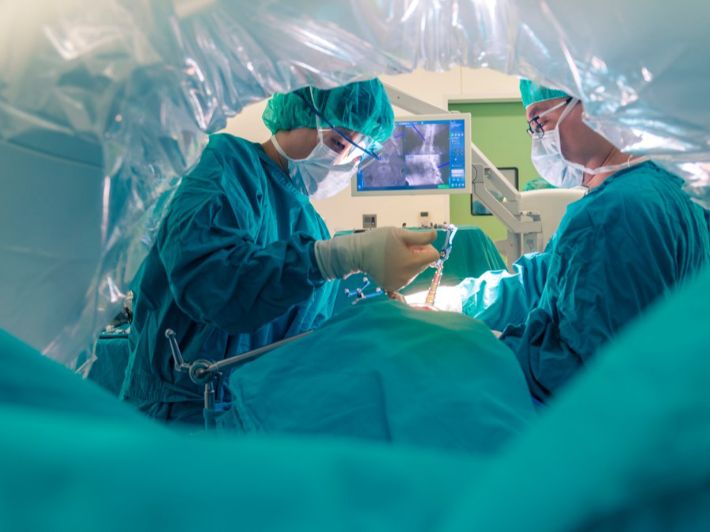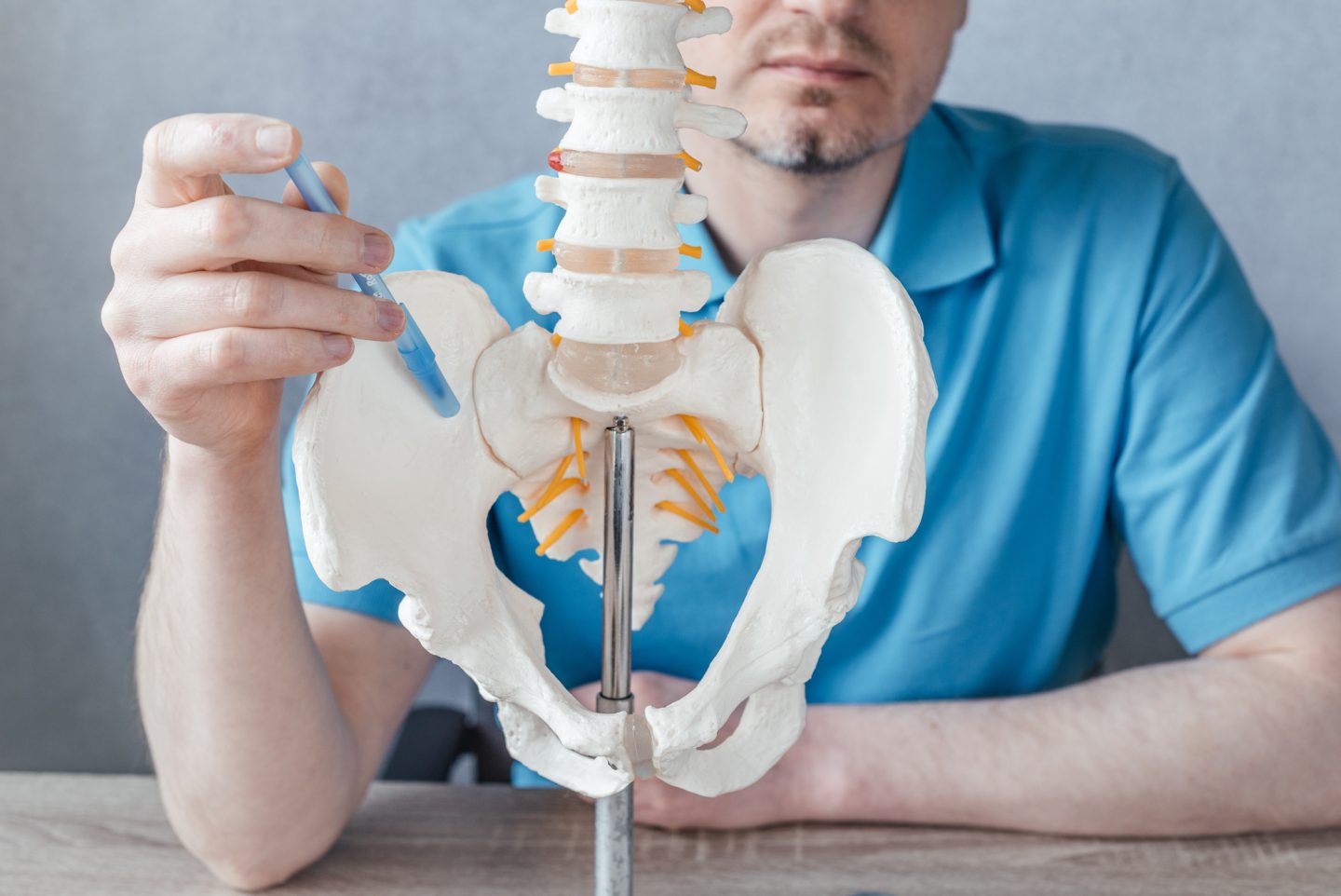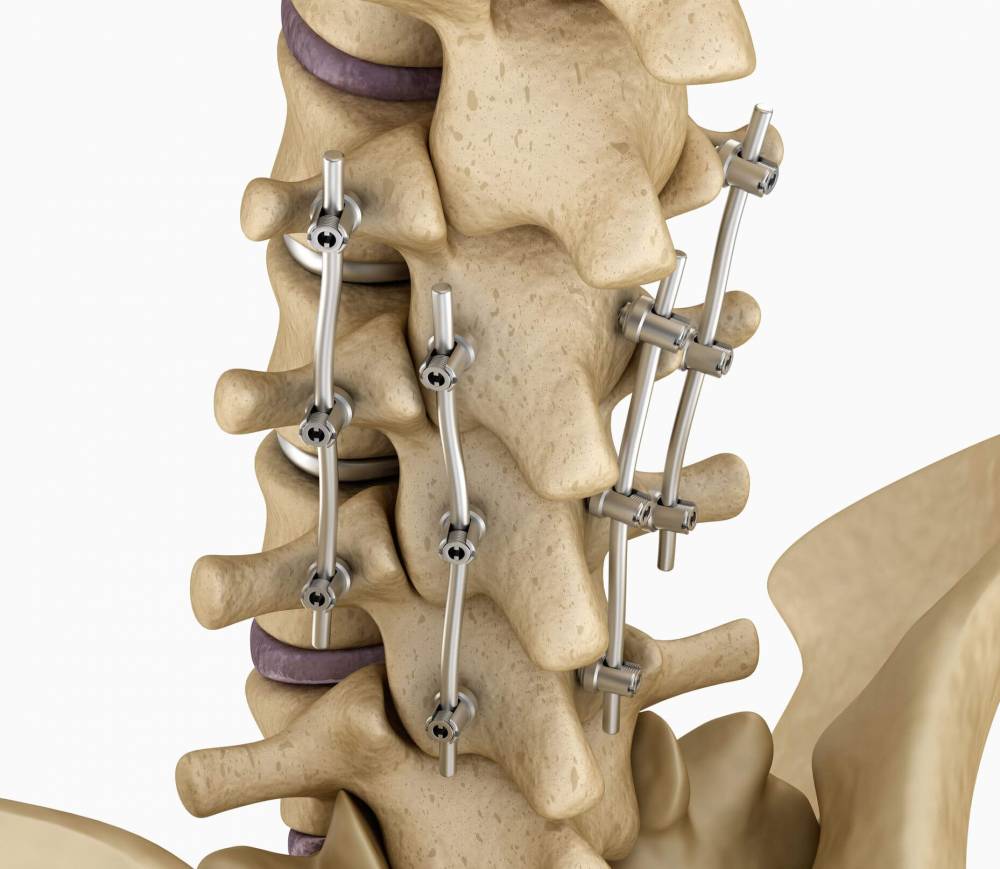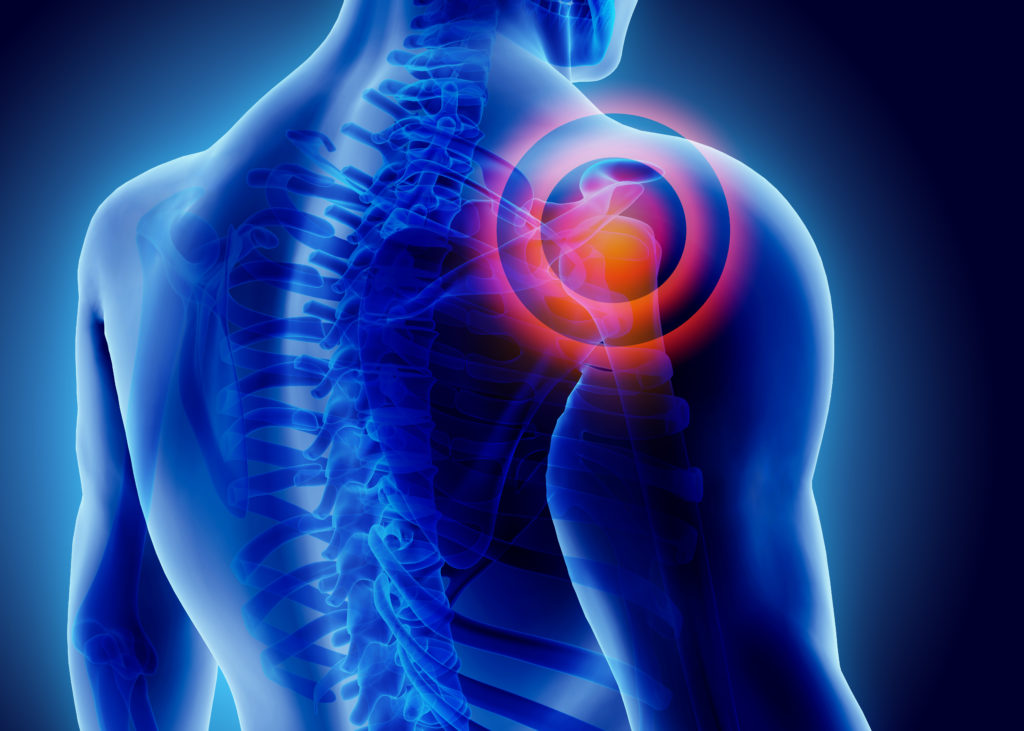Laser Disc Herniation Surgery
Laser Disc Herniation Surgery, Disc herniation is a common injury that can cause severe pain and hinder an individual’s ability to carry out their daily activities normally. There are various medical procedures available to treat disc herniation. In the following article, we provide detailed information about laser disc herniation surgery, how it is performed by an orthopedic surgeon, its advantages, post-operative instructions, and other related medical information.
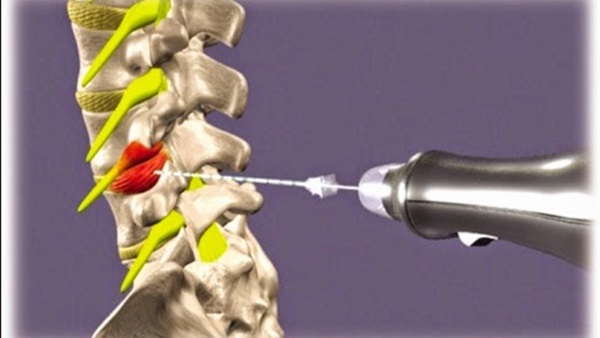
Laser Disc Herniation Surgery
In most cases, complete removal of the disc in the lumbar or cervical vertebrae is not performed after a herniation. Instead, the doctor assesses the extent of the injury and its impact on the surrounding areas. There are several treatment options available, including surgery to remove the protruding part of the disc that is causing pain in the spine using laser technology.
The idea behind laser disc herniation surgery in Egypt involves limited surgical intervention. The doctor performs the surgery through the following steps:
- No cuts or holes are made in the skin for the procedure.
- The surgery is conducted under local anesthesia, not general anesthesia.
- The surgeon inserts a needle of fine diameter into the affected part of the disc.
- The location of the herniated disc is identified using X-ray imaging.
- The needle applies thermal frequencies at a specific degree to cauterize and vaporize the affected part.
- The surgery takes a short time, ranging from 30 to 45 minutes.
- The patient can return home on the same day.
- Driving is not recommended on the day of the surgery.
Disc Herniation
“Get an accurate assessment and a customized treatment plan for spinal disc herniation by consulting with Dr. Amr Amal.”
The spine is cushioned by discs, which are flexible tissues that absorb shocks and provide the necessary flexibility for vertebral movement without friction, allowing pain-free movement and bending. Disc herniation, one of the injuries that the back discs can suffer from, affects a person’s ability to move and bend the spine.
Disc herniation occurs when a part of the disc between the vertebrae moves out of its original position, causing the vertebrae to touch and rub against each other. This results in severe pain and pressure on the nearby spinal cord nerves, leading to inflammation over time, numbness, tingling, and an increased sensation of pain.
There are three degrees of disc herniation in the back, determined by the extent to which the intervertebral disc has shifted from its original position. Disc herniation starts with a small protrusion outside the vertebrae, gradually worsening to a tear in the fibrous ring and protrusion of the nucleus. In the final stage of herniation, the larger part of the disc is damaged and protrudes outwards.
Causes of Herniated Disc
A person may suffer from a herniated disc, also known as a disc prolapse, for various reasons, including the following:
- Overexertion at work leading to damage and wear of parts of the disc, which generally weakens it.
- Pressure on the vertebrae through suddenly lifting heavy objects.
- Exposure to a spinal injury after an accident.
- Herniated discs can occur in women during pregnancy.
- Direct fall on the back or collision.
- Excessive obesity negatively affects the disc in the back, making the person susceptible to a disc prolapse.
- Weakness in the muscles of the neck or back due to genetic or acquired factors.
What are the Types of Herniated Discs?
Herniated discs are classified based on their location into three types as follows:
- Lumbar Herniated Disc: This is one of the most common types of disc prolapse among many people, where the protrusion occurs in the discs located between the lumbar vertebrae.
- Cervical Herniated Disc: This is the second most common type, where the protruding disc is located between the cervical vertebrae.
- Thoracic Herniated Disc: This is the least common type, with a protrusion in the disc located between the thoracic vertebrae.
Symptoms of Herniated Disc
Symptoms of a herniated disc appear gradually on the patient, depending on the degree of prolapse. Most often, disc prolapse occurs in the lumbar or cervical vertebrae of the spine because they bear a large part of the body’s weight, which affects them and accelerates the wear of the disc located between these vertebrae.
Symptoms of Lumbar Herniated Disc:
- Sharp pain in the lower back that increases when bending or lifting heavy objects, with pain radiating to the thigh and leg. This pain occurs in episodes that increase when transitioning from standing to sitting or vice versa.
- Feeling muscle weakness and an inability to perform daily activities as easily as before.
- Experiencing tingling and a sensation of pins and needles in the lower back, leg, and sole of the foot, which increases after sitting for a long time.
- Difficulty in controlling the bladder and occurrence of urinary incontinence, which is a warning sign of increased severity of herniated disc symptoms.
- Difficulty walking or standing for long periods.
Symptoms of Cervical Disc Herniation:
- Feeling pain in the neck and difficulty in head movement.
- Sharp, unilateral or bilateral pain in the neck, extending to the shoulder.
- Stiffness in neck muscles and limited movement due to pain.
- Pain intensifies when bending the neck or making sudden movements like sneezing or coughing. For more on cervical disc herniation symptoms, click here.
Symptoms of Thoracic Disc Herniation:
- Feeling pain in the chest, radiating to the ribs and back.
- Inability to breathe properly due to chest muscle pain and discomfort.
- Pain intensifies during sneezing and coughing.

How is Disc Herniation Diagnosed?
- Diagnosing disc herniation is done through examining the patient’s medical history and assessing risk factors such as obesity, smoking, etc.
- A thorough examination of the painful area, checking the nerve response and muscle strength at the injury site.
- Diagnostic imaging tests such as X-rays, CT scans, and MRI scans.
What are the Complications of Untreated Disc Herniation?
- Failing to follow appropriate treatment methods or neglecting early intervention for disc herniation can lead to complications, including:
- Acute and chronic nerve pain.
- Cauda equina syndrome.
- Loss of bladder control.
- Numbness and tingling in the lower extremities.
- Nerve damage affecting the person’s movement.
Modern medicine offers various treatment methods for those suffering from disc herniation, enhancing the chances of recovery and avoiding potential complications that could harm the patient. Consequently, the person feels an improvement in their health condition, and early treatment increases the chances of avoiding risks.
When is Disc Herniation Dangerous?
- Often, disc herniation can be treated without surgical intervention, relying on medications, conservative therapy, and an appropriate dietary program for weight loss in obese patients. Afterwards, the disc starts returning to its natural position and symptoms decrease.
- The danger of disc herniation arises when symptoms intensify and complications occur, such as numbness in the leg, severe pain during movement or sitting, and in some cases, the patient may experience urinary incontinence. In these situations, surgical intervention becomes the best option for the patient.
What is the treatment for disc herniation?
The treatment for disc herniation varies, as it depends on the extent of the damage that has occurred in the disc and the vertebrae, and to what extent it has affected them. If the patient is in the first or second stage of disc herniation, conservative and medicinal treatment, rest, and weight reduction, along with sufficient physical therapy, can improve their health condition. However, this requires some time.
If the disc herniation affects the nerve in the early stages of injury, Dr. Amr Amal, a consultant in orthopedic surgery and joints at Ain Shams, recommends that the patient undergo surgery. This helps the patient feel comfortable and be able to return to their normal physical activity in a shorter time without affecting the spinal cord and its nerves. The surgical option, which includes total or partial removal of the disc with fusion of the vertebrae, is then considered.
How to treat disc herniation non-surgically?
A person with disc herniation can follow the following treatment instructions:
- Start taking painkillers and steroidal anti-inflammatory drugs.
- Increase rest time and try to sleep correctly to give the body a chance to recover.
- Use cortisone injections in the affected part of the back, which helps the patient feel more comfortable.
- Physical therapy plays an effective role in treating and relieving the pain of disc herniation, and it helps increase the person’s ability to live a normal life.
When does a disc patient need surgical intervention?
A disc patient is exposed to more than one degree of slippage in the back vertebrae disc, which affects the condition of the vertebrae and the patient’s ability to move directly. In general, the treating doctor conducts a full diagnosis of the patient, either physically or through imaging, to determine the degree of injury and its impact on the back vertebrae.
Surgical intervention is necessary if the patient is elderly and the disc has worn out, or if the nerve near the vertebra is affected by the herniation, causing the patient to feel severe pain when making any movement. This continuously affects their activity. Therefore, disc herniation surgeries at this stage are considered the best solution. Learn about the latest techniques and developments in treating spinal disc herniation through the experience of Dr. Amr Amal in this field.
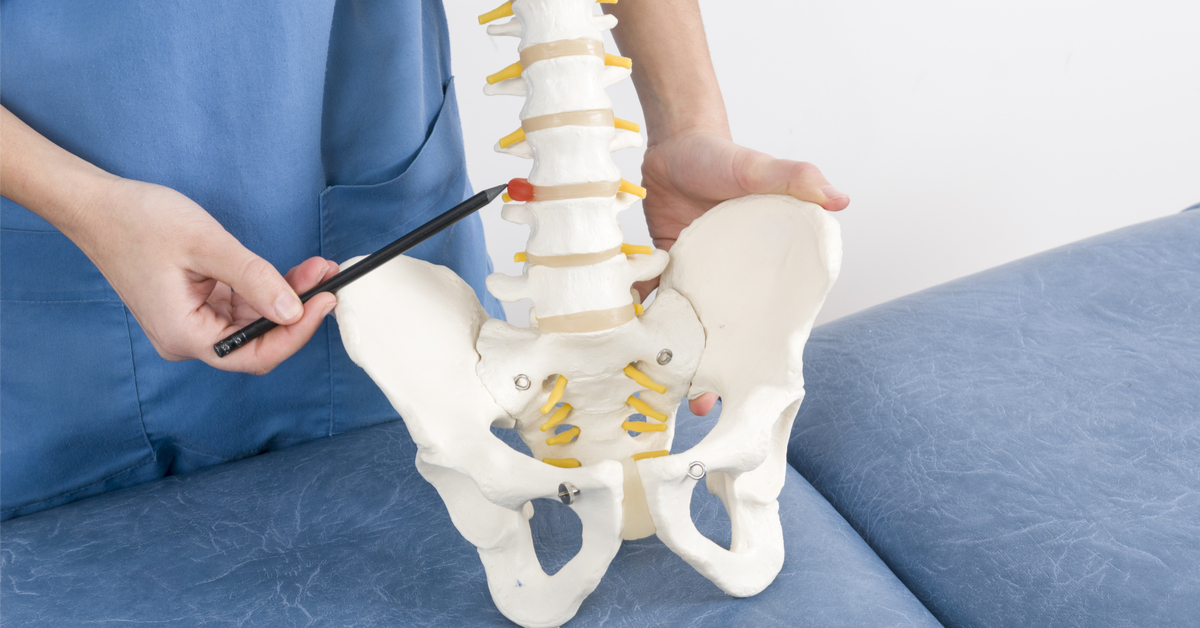
Is there laser disc herniation surgery?
Current scientific advancements have led to modern methods of treating disc herniation, including laser disc surgery. It is one of the safe surgical procedures recommended by orthopedic doctors for its effectiveness and the significant successes it has achieved in recent years. It does not cause complications for the patient.
Laser Disc Herniation Treatment
Disc herniation surgery in Egypt has become more widespread recently due to its effective results in treatment, which help heal disc herniation faster and reduce the severity of pain felt by the patient. It also provides them with the opportunity and ability to live a better quality of life.
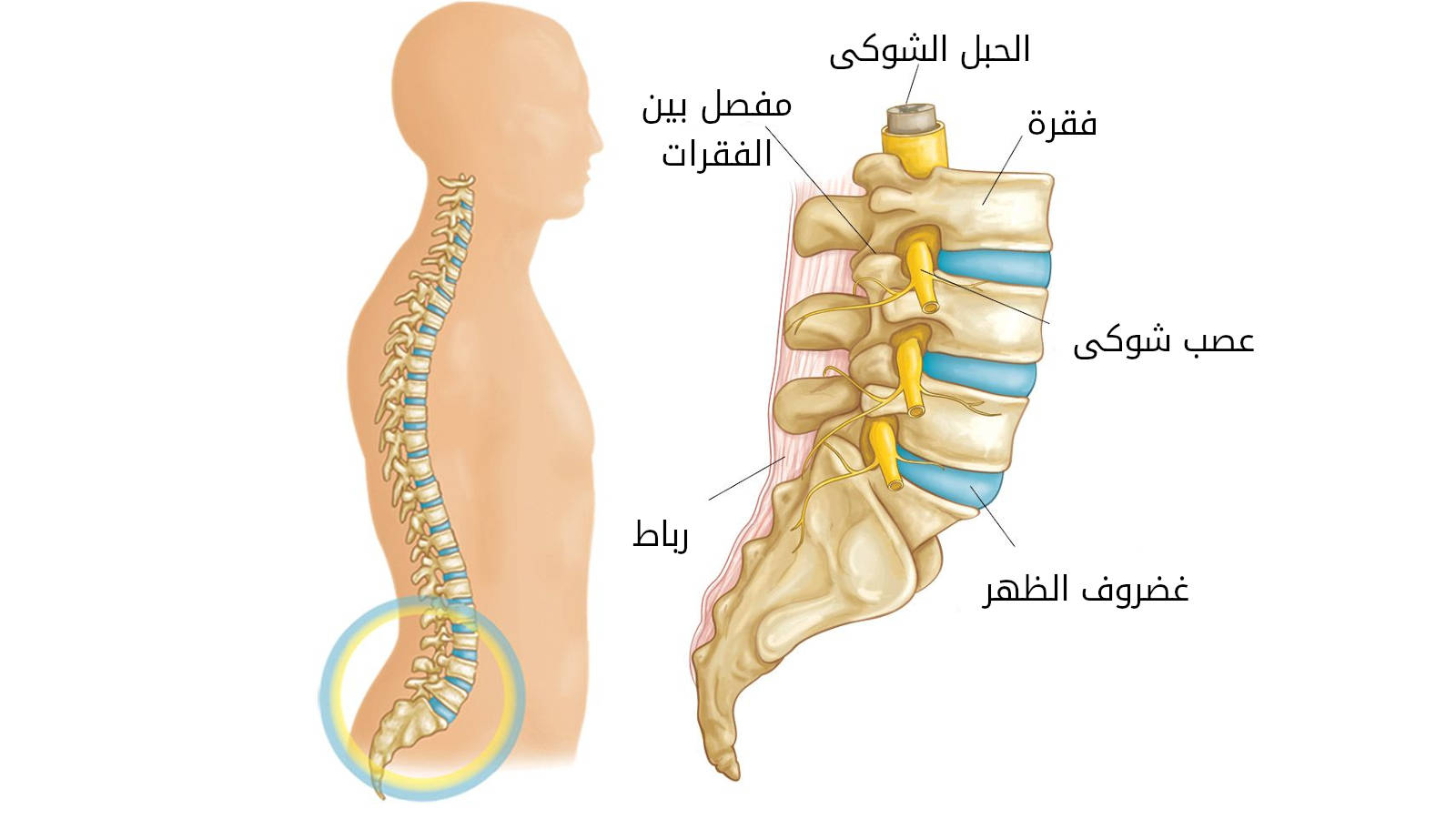
Steps of Laser Disc Herniation Surgery
Laser spine surgery, or laser disc herniation surgery, is considered one of the latest medical procedures followed, which is carried out through several steps as follows:
- The doctor begins by preparing the patient for the operation and determining the appropriate type of anesthesia, which is usually local anesthesia.
- X-ray devices are used to identify the exact location of the herniation and also the location of the surrounding nerve roots.
- The surgeon uses a tool resembling a needle, inserts it into the specified part, and directs a beam of low-level frequencies, which work to suck and vaporize the disc, thus making the person feel more comfortable and relieving pressure on the nerves.
- The tool is removed, a small dressing is applied, and the patient is transferred to the recovery room to monitor their health condition and ensure that no complications have occurred.
- This procedure may be followed by a thermal frequency session, which aims to treat excessive inflammation in the nerves and alleviate it, providing the patient with greater and faster relief.
- The patient usually leaves the hospital on the same day, but it is important to follow the doctors’ instructions after the surgery.
Postoperative Instructions for Laser Disc Herniation Surgery
The doctor begins to follow up on the patient’s recovery steps and advises them on the following procedures:
- Taking the prescribed types of pain relievers until the pain from the herniation completely subsides.
- Starting to exercise in accordance with their rehabilitation program.
- The patient should not engage in vigorous exercise or lift heavy weights immediately after the surgery.
- It is necessary to consult the specialist doctor in case of an increase in body temperature or if the pain returns.
Laser Cervical Disc Surgery
The cervical vertebrae are the first part of the spinal bones, which help in movement in different directions, and through them runs the spinal cord, just like the rest of the back vertebrae. It is possible for some types of injuries to occur in them, including disc herniation, which causes severe pain due to nerve inflammation and bone friction in the event of disc degeneration.
Laser Disc Cauterization
This is one of the procedures that has been performed, and it is minimally invasive, meaning it does not cause damage to the tissues, thereby minimizing harm to the patient. It is done through cauterizing the affected disc with laser, which removes the pain and allows the person to return to their normal activity, improving their quality of life. The advantages of laser include:
- Preserving the tissue around the affected part.
- The ability to use local anesthesia.
- The short duration of the procedure, which can be up to 20 minutes.
- The patient is then able to leave the hospital on the same day.
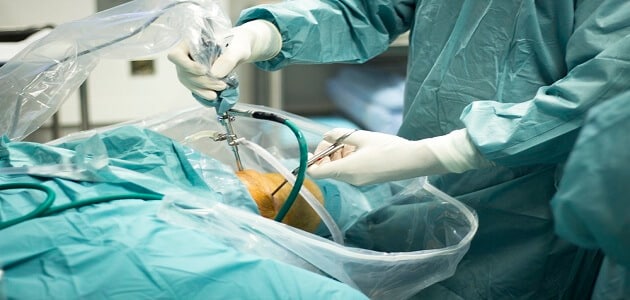
What is the difference between laser surgery and endoscopy?
Laser and endoscopic procedures for treating herniated discs and other diseases are among the minimally invasive methods, and their aim is to preserve tissues. They are safer than traditional surgeries, have many advantages, and have proven their effectiveness over the years. We will discuss some of the differences between them as follows:
Laser Disc Surgery
The concept of laser in this surgery relies on inserting a special needle into the affected area and applying a frequency that treats the herniated disc, improving the patient’s condition without any incision made by the doctor. The procedure requires a short duration to be performed.
Endoscopic Disc Surgery
Endoscopic herniated disc surgery is performed through three small holes in the affected area to insert the endoscope and the tools used for the surgery. Through this, the protruding part of the disc is removed, relieving pressure on the nerve, treating inflammation, sterilizing the holes, dressing them, and then the patient is discharged from the operation room.
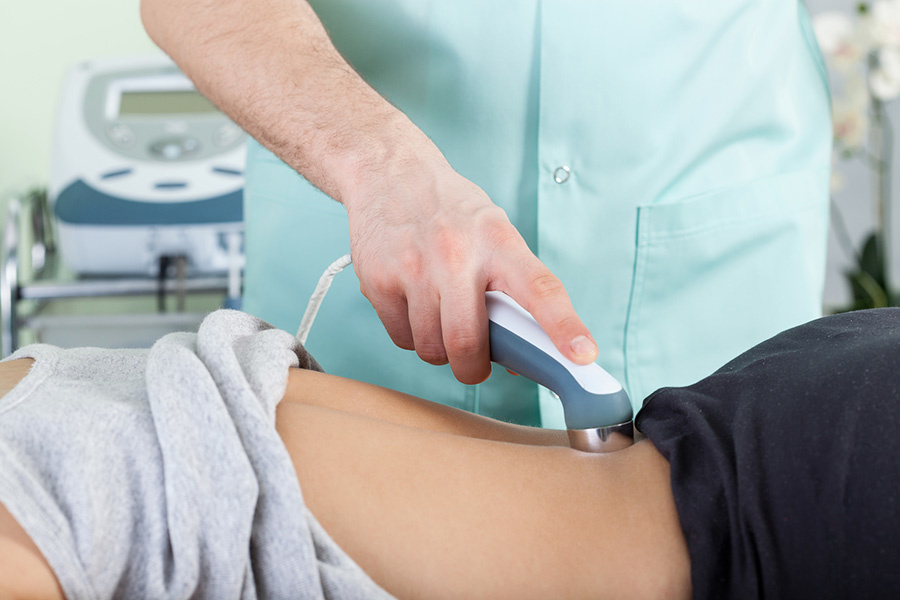
Advantages of Laser Herniated Disc Surgery
Laser technology in performing herniated disc surgery has several good advantages for disc patients, including:
- The operation is performed in a short duration.
- No incision is made.
- It is a minimally invasive surgical procedure.
- It does not cause damage to tissues or skin.
- Suitable for people with chronic diseases such as high blood pressure and diabetes.
- Faster recovery compared to traditional surgeries.
- Quicker return to daily activities.
- Fewer complications that may follow the surgery.
- The surgery is performed under local anesthesia.
- The cost of the procedure is less than traditional medical procedures.
Postoperative Procedures for Herniated Disc
The laser herniated disc surgery does not require many medical steps or instructions, but all the patient needs is to take some rest, drink fluids, take the painkillers prescribed by the doctor, and follow a balanced diet post-surgery to reduce weight that might affect the disc again. Also, the patient should follow the specified therapeutic program after the surgery.
What is the recovery time from a disc herniation surgery?
“We provide you with comprehensive care and innovative solutions for spinal disc herniation problems by Dr. Amr Amal.”
Traditional surgical treatments for disc herniation require 4 to 6 weeks for the patient to return to their normal activity. However, in the case of laser disc herniation surgery, the recovery time is definitely shorter. During the recovery period from disc herniation surgery, the patient undergoes a special physical therapy program to strengthen muscles and improve mobility after surgery.
The cost of laser disc herniation surgery in Egypt
Determining the cost of disc herniation surgery in Egypt depends on the location of the surgery, the treating physician, and other factors that must be considered before knowing the prices of laser disc herniation surgery. The medical team accompanying the doctor usually clarifies these details before the surgery. If you want to learn more about laser disc herniation surgery, the latest prices in Egypt, and the best medical centers that specialize in it, we advise you to read the following article.
How should a disc herniation patient sleep?
Proper sleeping positions significantly help the patient feel comfortable after the surgery and speed up the recovery process without facing serious complications. A disc herniation patient can sleep in one of the following three positions:
- Sleeping on the back with comfortable pillows under the knees to reduce pressure on the back vertebrae and another pillow under the head.
- The patient sleeps on one side, using pillows between the knees and slightly bending them in a fetal-like position, which reduces the curvature of the back vertebrae.
- Sleeping on the stomach, which is the least comfortable position. The patient sleeps on the stomach with a pillow under the head and another pillow under the abdomen to help relieve pain symptoms by lifting the pressure off the spine.

Can disc herniation be prevented?
Here are some tips and instructions to help reduce the risk of disc herniation, including:
- Engaging in physical exercises that help strengthen the back and abdominal muscles.
- Ensuring to follow a healthy diet to maintain and strengthen the body’s bones, ensuring their health and strength.
- Maintaining an appropriate body weight and avoiding excessive weight gain to prevent putting additional strain on the back muscles and spine.
- Avoiding sudden movements and ensuring to sit and stand up correctly.
The Best Doctor for Laser Disc Herniation Surgery in Egypt
Dr. Amr Amal is one of the best specialists in Egypt for performing laser disc herniation surgeries, boasting a good reputation and extensive experience in this field, making him the ideal choice for those suffering from lumbar disc issues in the spine.
Dr. Amr Amal is distinguished by his high skills and use of the latest techniques and advanced technological equipment in performing laser disc herniation surgeries. He adopts an adaptive approach that takes into account the condition of each patient individually, focusing on providing the best therapeutic solutions and personal care.
In addition, Dr. Amr Amal provides the highest levels of healthcare and continuous follow-up after the surgery. He cares for the patient’s health before and after the surgery, providing them with the necessary information and correct medical guidance to enhance the healing process and achieve the best results.
Thanks to his successful professional history and a wide range of cases that he has successfully treated, Dr. Amr Amal enjoys the trust and respect of both patients and colleagues alike. He works diligently and is committed to improving the quality of life for patients and alleviating their pain through providing a satisfactory and safe solution for laser disc herniation issues.
In summary, there is no better facility than Dr. Amr Amal’s clinic for undergoing laser disc herniation surgery in Egypt. With the precision and dedication he puts into his work, you will find that the results of the surgery will be satisfactory, and you will regain your vitality and quality of life.

